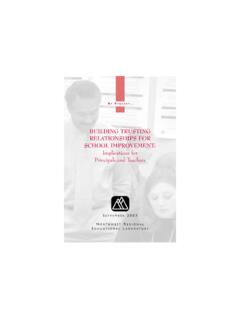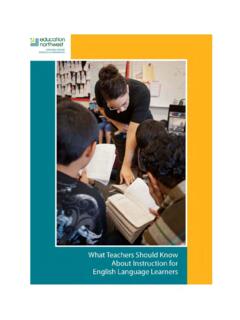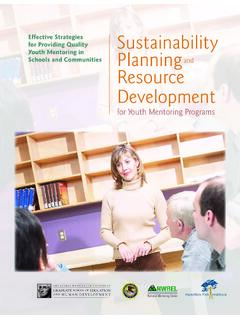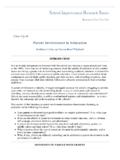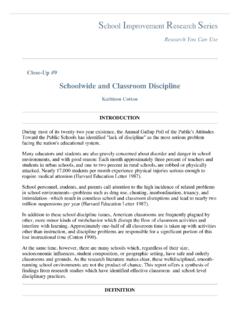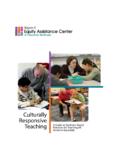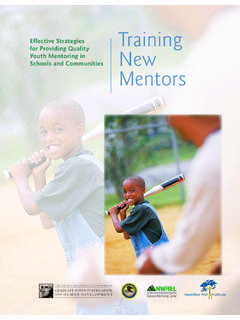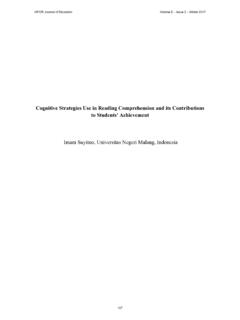Transcription of Instructional Grouping in the Classroom
1 SCHOOL IMPROVEMENT RESEARCH SERIESR esearch You Can UseClose-Up #2 Instructional Grouping in the Classroom1987 Beatrice A. WardINTRODUCTIONThe knowledge base regarding use of Instructional Grouping in the Classroom includes findingsfrom research on effective schools, effective teaching, student academic achievement, studentperceptions of self and others, student motivation, student attitudes toward school, and studentfriendships and interactions in the Classroom and school. A dominant theme in the researchfindings is that some types of Instructional Grouping contribute to more positive academic andaffective outcomes for students. Other groups, particularly stable, long-term groups based onstudent ability, have a negative effect upon Close-Up synthesizes this research for use by teachers, school principals and others who wishto improve the quality and effectiveness of the educational opportunities provided to students intheir Classroom has been grouped when the one large group of students assigned to that Classroom isdivided into a set of smaller groups for some portion of the time they are in the Classroom .
2 Whilein operation, each small group is recognized and treated as a separate and distinct social entity bythe teacher and the students in the Classroom . To be considered Instructional , the activities carriedout by students in a small group must include learning of educational TYPES OF Instructional GROUPS ARE USED BY TEACHERS?Teachers place different configurations of students in Classroom Instructional groups, assign thegroups different sorts of learning goals and tasks, evaluate student performance in different waysand maintain group membership for different periods of time. Several types of groups result. Moreeffective teachers use more that one type of CYCLE GROUPSS tudents with similar learning needs are brought together for a short are assigned to groups based on need for additional help, time and practice in orderto master the content and skills covered in a particular unit or lesson the teacher already hastaught to the entire Classroom who have mastered the specific content and skills engage in enrichment GROUPSC ooperative groups require students with diverse ability and characteristics to work together andlearn from one another to accomplish assigned learning goals or tasks.
3 Recent research has focusedon three types of cooperative INVESTIGATIONA small group of four to six diverse students is assigned a topic of students are assigned subparts of the work to be of assigned tasks requires each student's work to be combined with that of otherstudents to produce a group may be assigned to play different roles in the group completion is contingent on group's collective product is evaluated. Each student's performance is judged based onthis evaluation and, in addition, may include an individual score for the subtask completedby the membership changes for different , there is no inter-group TUTORINGA small group of four to six students with a cross section of characteristics is formed toteach information and assigned to groups emphasize material previously taught to the entire class by tutoring approaches include:1.
4 TEAM ASSISTED INDIVIDUALIZATIONEach student receives an individual assignment based on learning team goal is to help one another complete assigned tasks successfully and to improve eachstudent's performance on a quiz measuring skills and content covered in the student's receive individual team receives recognition based on amount each student's score exceeds average or pastperformance on skills and content covered in individual TEAMS AND GAMESA fter studying content and skills in learning teams (see above), students are combined intotournament groups based on student's performance in tournaments contributes to individual and learning team groups are temporary for particular skill or content teams are JIG-SAWM aterial to be learned is broken into student is to learn a section and then teach it to other team student is tested and graded individually on entire set of are temporary based on material to be learning TOGETHERA small group is given one assignment sheet.
5 The group completes and hands in this is based on how well students work together to complete the assignment sheet andperformance on completed developmentSmall groups of four to six students are formed. Generally the students in each group havediverse assigned to groups are complex, , tasks with more than one answer or way to solvea engage in learning activities such as reenactment of historical events; dramatizations; Instructional games; and development of fictional events, countries or governments, and plan what to do and assign subtasks, if any, to students based on group frequently includes qualitative as well as quantitative rating of final are ABILITY GROUPSS tudents are assigned to groups based on academic in group assignments occur only when a student's academic performance seldom change.
6 For the most part, a student's assignment to an abilitygroup level in kindergarten will be maintained through grade three and changes are based on factors other than achievement, , social behavior andneatness, and are to a lower rather than higher ability in small group is may be provided in a "pull-out" situation in which students are taught by adifferent teacher from the one who teaches the class. Group instruction may take place in asetting outside the regular are evaluated IS Instructional Grouping USED?TO ASSURE THAT ALL STUDENTS LEARNT otal Classroom groups typically include students with a variety of differ in mastery of the skills and knowledge prerequisites for successfullearning in that differ in the time needed for learning a given unit of material or to attain aparticular educational objective.
7 The slowest 10 percent of students need to 6 timesas much time as the highest 10 differ in race, sex, socioeconomic level of parents and differ in self-concept, interest in school, motivation to learn and personaleducation such student heterogeneity is one of the most troublesome and enduringproblems faced by high and low ability students do better academically in classes where the total groupincludes students with a wide range of academic ability. The impact is greater on low abilitystudents. There is no difference in average ability students' academic performance in classesthat are academically heterogenoous or lesson-by-lesson Instructional groups provide review, practice and enrichmentopportunities that effectively meet the diverse learning needs of students in a Instructional Grouping is used to reduce the range of differences in the studentsbeing taught at a given point in time, the abilities of students in the various groups, evenlong-term ability groups.
8 Overlap studies of small group versus whole class instruction find greater learning on the partof students when the teacher uses small Instructional groups for at least part of the and low ability students benefit more than average gains are less clear in mathematics than reading. In math, students inpeer tutoring groups show more significant gains in math computation than in mathconcepts and applications. Students who complete group investigation tasks acquiremore high level math skills than those engaged in total class group experiences increase girls' achievement more than boys'.Student achievement in Instructional groups is related to the teacher 's ability to solveclassroom management problems associated with the use of small exception to student achievement gains occurs in long-term ability achievement effects are found only for high ability students, and these resultsoccur only in some effects occur for moderate ability students beyond the learning that occurs whenthese students are taught in a total Classroom effects are identified for low ability students.
9 Pull-out low ability groups havea particularly adverse impact upon the performance of low ability desegregated classrooms, cooperative learning groups produce significant gains inacademic achievement for minority group cooperative groups, students who help others by providing explanations or demonstrationsof how to complete assigned tasks gain more in achievement than students at the same abilitylevel who are recipients of investigations, particularly ones that do not include competition between teams,promote use of abstract thinking, problem solving, and critical thinking change over time. This should lead to changes in their Instructional ability groups are used, exit criteria should be specified so it is clear when astudent should be moved to another teachers do not give specific attention to accommodating changes in studentsand have no criteria for exiting an ability group, student assignments to ability groupsremain stable.
10 At most, six percent of the students in a Classroom will be moved fromone group to another. And, for the most part, these changes will be based on students'nonacademic characteristics or INCREASE STUDENT ENGAGEMENT IN LEARNINGHigh levels of student on-task time occur in small groups. In particular, low ability studentsspend much less time off task in cooperative small group situations than in total classinstruction largely because they spend less time in waiting for instructions and of low ability students decreases as the diversity of the students in the smallgroup decreases. When all students in a group are low ability and their placement in thegroup extends for more than a few days, these low ability students have almost twice asmuch off-task time as students asigned to long-term high ability groups.
